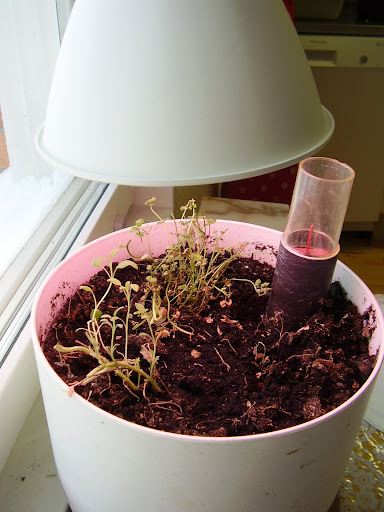
In the beginning it looked like this. The plants had survived a long swedish winter in one of our darker windows.

After a few days with grow lights, it looked like this.

And now I have mint enough to drink tea made from fresh leaves several times a week, and have problems finding purposes for my amounts of sage. Clearly an indoor gardener, at least an indoor gardener with the ambition of growing eatable things, cannot do without extra light. But why?
The reason is that the plant need three things to survive; light+water+soil (ie. nutriants from...). It needs light of the right amount and quality in the same way it needs nutriants of right amount and quality.
During the summer in Sweden (we are roughly at the same longitude as Canada) most plants are doing pretty well since we have almost the same amount of lights as in the tropics. In the winter, however, we have only a third or in worst case a twohundredth part. Our human eye cannot register those big differences, but the plants do - and starves.
If you are gardening indoors you need to think both of the right amount of light for the season, and the right quality of light. Roughly light is divided into red and blue, where red gives long plants and blue compact and leafy ones. Gardeners deep into this field has long ago lost themselves into the world of lux, lumen and LED. I might join them in the future, but today we're looking at the basics.
The easisest way to get good light is to visit the apropriate chain in gardening or hardware or do it your self. I bought mine at a swedish hardware/do it yourself chain. When you find flourescent lights neetly labled "grow light", buy it. If you want to grow in big pots, buy a long 'normal' flourescent light and the appropriate armature.
Now, grow light tend to be expensive, so it may come as a relief that if you are keeping your plants in your windowsills you can make do with complementing the sunlight. In that case you can buy normal full colour flourescent light.
The last part was interesting for me. My instant herbgarden and sow box are endowed with a futuristic bluewhite light. Eventhough it's been up for several days I haven't noticed any difference like I did with the sage and mint. I guess the light is of inferiour quality, which means I have to change. Full colour light will dig a hole in my budget, but a far smaller one than 'real' grow light. I'll update on this subject.
3 comments:
Thanks, I'm honoured! Consider it done.
I love your blog,
I am adding your site to my links pages
http://www.fuzzlight.com
I struggled to get many of my plants to grow indoors when I first began using grow lights. Your tips have actually been very helpful. While I have had more success recently, I still struggle getting some foods to grow. They seem to all burn up and wither within a couple of weeks.
Post a Comment